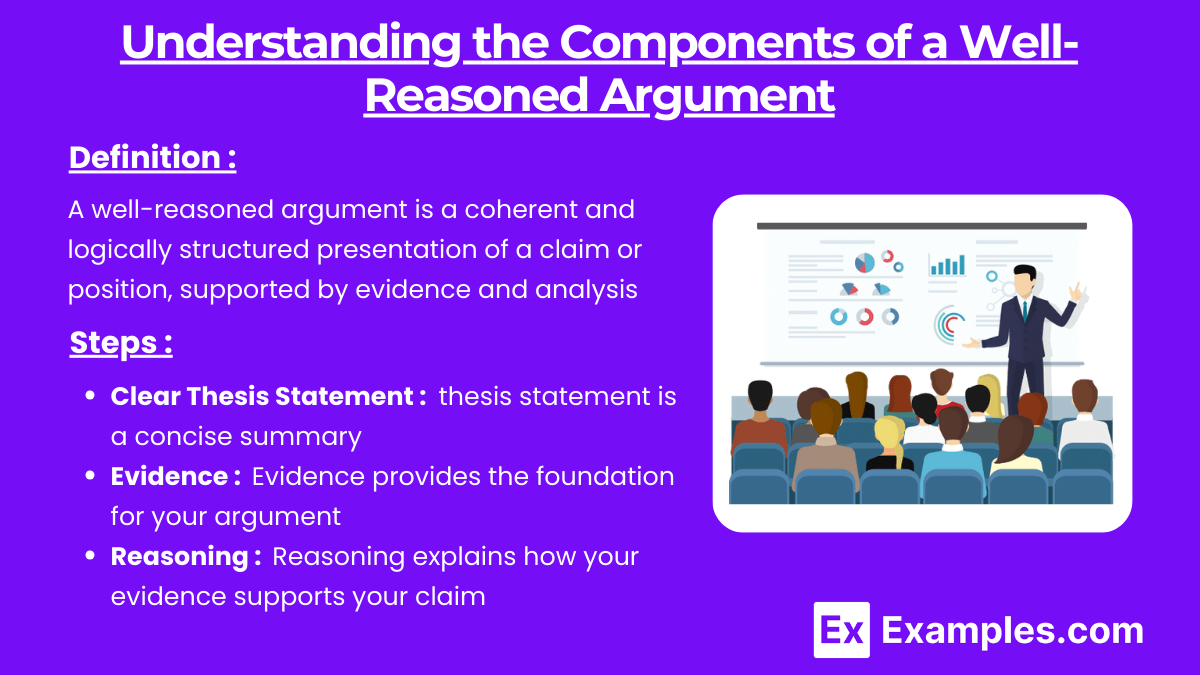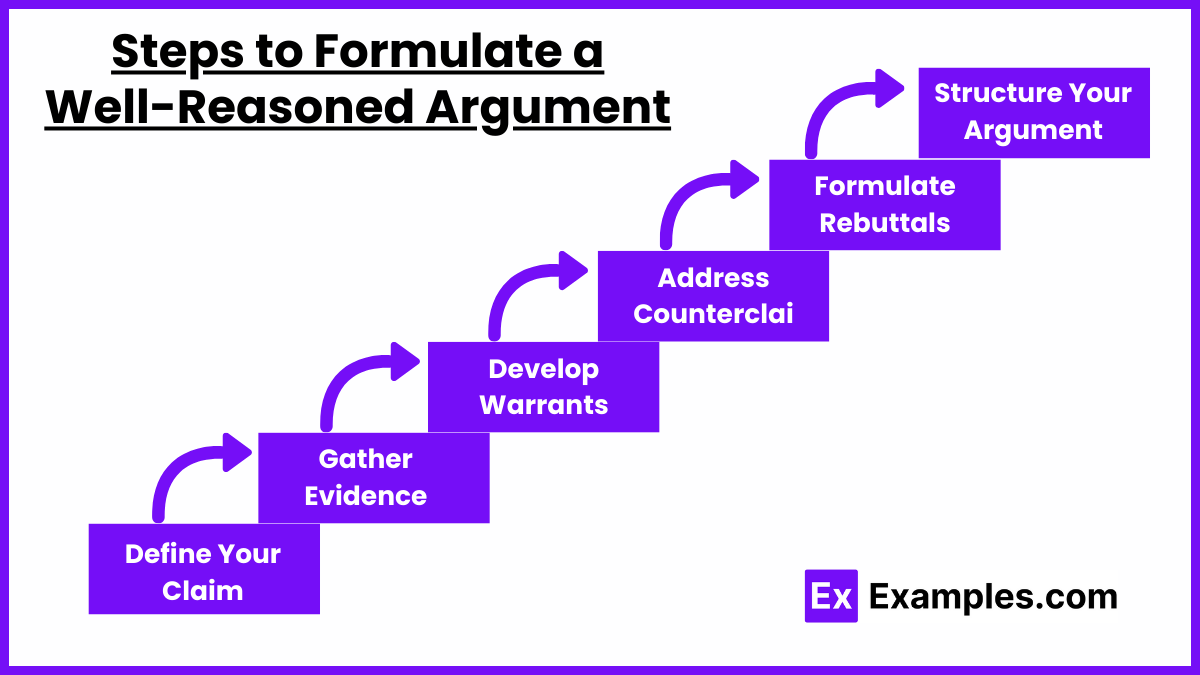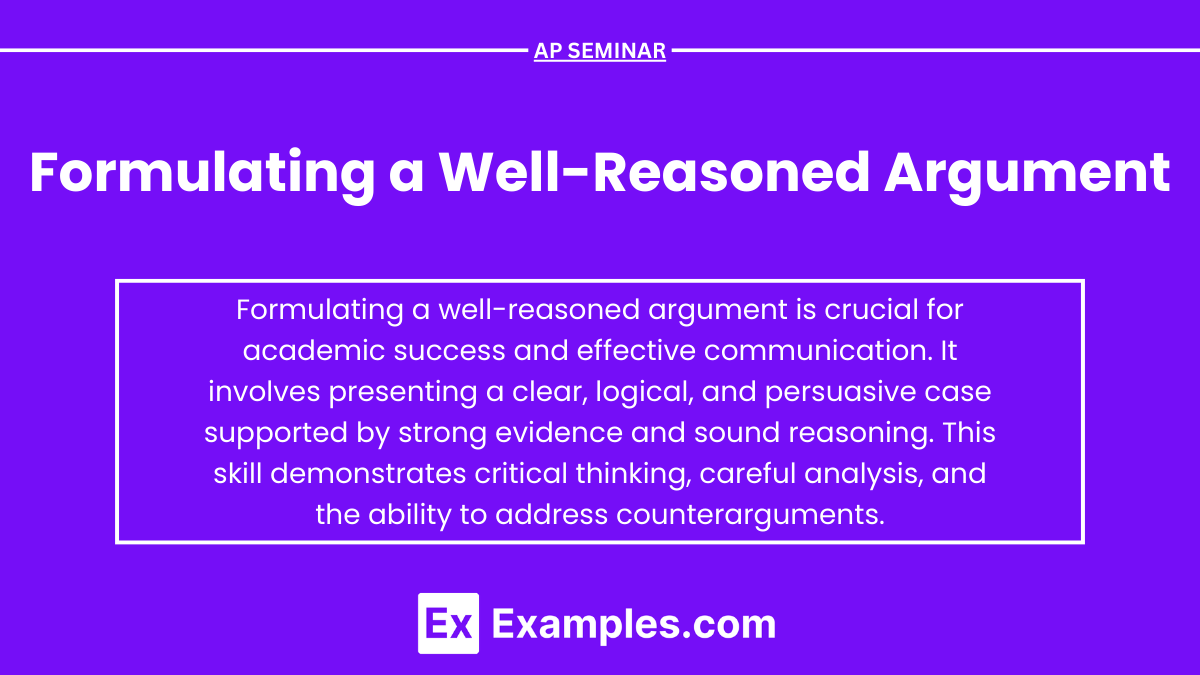Formulating a well-reasoned argument is crucial for academic success and effective communication. It involves presenting a clear, logical, and persuasive case supported by strong evidence and sound reasoning. This skill demonstrates critical thinking, careful analysis, and the ability to address counterarguments. By mastering the components of a well-reasoned argument, such as a clear thesis, relevant evidence, and logical reasoning, students can create compelling arguments that resonate with their audience and achieve high scores in exams like the AP Seminar.
Learning Objectives
In the AP Seminar exam, you should learn to formulate a well-reasoned argument by developing a clear and concise thesis statement, gathering and evaluating credible evidence, and using logical reasoning to connect your evidence to your thesis. Additionally, you should learn to address counterarguments effectively, organize your argument coherently, and revise your work for clarity and coherence. Mastering these skills will enable you to present persuasive and well-structured arguments that meet the rigorous standards of the AP Seminar exam.
Understanding the Components of a Well-Reasoned Argument

A well-reasoned argument is a coherent and logically structured presentation of a claim or position, supported by evidence and analysis. It addresses counterarguments and demonstrates critical thinking.
1. Clear Thesis Statement
- Definition: A thesis statement is a concise summary of the main point or claim of your argument.
- Importance: It guides the direction of your argument and informs the audience of your position.
- Example: “Implementing renewable energy sources is essential for mitigating climate change and ensuring sustainable development.”
2. Evidence
- Types of Evidence:
- Facts and Statistics: Numerical data supporting your claim.
- Expert Testimony: Quotes or insights from authoritative sources.
- Examples: Real-world instances that illustrate your point.
- Importance: Evidence provides the foundation for your argument, making it credible and convincing.
3. Reasoning
- Definition: The logical connections between your evidence and your thesis.
- Importance: Reasoning explains how your evidence supports your claim and demonstrates the soundness of your argument.
- Example: “The rising levels of CO2 emissions correlate with the increased use of fossil fuels, demonstrating the need for renewable energy.”
Steps to Formulate a Well-Reasoned Argument

Step 1: Define Your Claim
- Clear and Specific: Ensure your claim is clear and specific, avoiding vague language.
- Debatable: Choose a claim that can be argued and is not a statement of fact.
- Example :Renewable energy should be prioritized over fossil fuels to combat climate change.
Step 2: Gather and Evaluate Evidence
- Credible Sources: Use reliable and authoritative sources, such as academic journals, books, and reputable websites.
- Relevant Information: Ensure the evidence directly supports your claim.
Types of Evidence
- Statistical Data: Provides numerical support for your argument.
- Expert Testimony: Quotes or insights from experts in the field.
- Case Studies: Detailed examples or real-life scenarios.
- Historical Evidence: Past events or trends that support your claim.
Step 3: Develop Warrants
- Explain the Connection: Clearly explain how your evidence supports your claim.
- Logical Reasoning: Use logical reasoning to connect your evidence to your claim.
- Example : Studies show that renewable energy sources emit significantly less CO2 than fossil fuels. Warrant: This evidence demonstrates that transitioning to renewable energy can reduce greenhouse gas emissions and mitigate climate change.
Step 4: Address Counterclaims
- Identify Counterclaims: Consider potential opposing viewpoints or arguments.
- Evaluate Validity: Assess the validity and strength of these counterclaims.
- Example : Renewable energy is unreliable and expensive. Evaluation: Acknowledge that renewable energy has higher initial costs, but highlight long-term savings and technological advancements improving reliability.
Step 5: Formulate Rebuttals
- Refute Counterclaims: Provide evidence and reasoning to refute counterclaims.
- Strengthen Your Position: Use rebuttals to reinforce the strength of your original claim.
- Example : While initial costs are high, the long-term economic and environmental benefits of renewable energy outweigh these costs. Advances in technology are making renewable energy more reliable.
Step 6: Structure Your Argument
- Introduction: Present your claim and provide context.
- Body Paragraphs: Each paragraph should present a piece of evidence and its corresponding warrant. Address counterclaims and provide rebuttals.
- Conclusion: Summarize your argument and restate the importance of your claim.
Tips for Writing a Well-Reasoned Argument
- Be Clear and Concise : Avoid unnecessary jargon and complex sentences. Ensure each sentence contributes to your overall argument.
- Use Transitional Phrases : Link ideas smoothly with phrases like “Furthermore,” “However,” and “In addition.”
- Address Counterarguments : 1. Acknowledge Opposing Views: Show that you have considered alternative perspectives.2. Refute Counterarguments: Explain why these perspectives are less convincing or flawed.
- Revise and Edit : Review for Clarity and Coherence: Ensure your argument flows logically. Check Grammar and Spelling: Correct any errors to enhance readability. Seek Feedback: Ask peers or teachers to review your argument.


